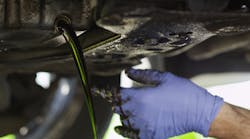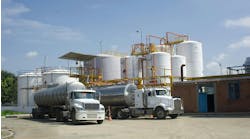The American Petroleum Institute (API) released the FA-4 engine oil specification nearly four years ago. While lubricant manufacturers stand behind the benefits of FA-4, slower OEM adoption and questions around engine protection with lower viscosity oils have some fleets debating whether to make the switch.
In 2016, API released the CK-4 and FA-4 diesel specifications to provide heavy-duty engine protection and help engines meet federal environmental regulations starting in 2017. The CK-4 specification replaced CJ-4 and is backward compatible with most applications in which a CJ-4 oil is recommended. CK-4 is designed to provide better shear stability, oxidation resistance, and aeration control than its predecessor. FA-4 oils provide similar improvements, according to API, but they are not backward compatible with earlier engines.
During an Oct. 1 FleetOwner webinar, Tony Negri, commercial products manager for Phillips 66 Lubricants, explained that the CK-4 category is a direct advancement of CJ-4, while FA-4 is a brand-new category to the segment. The F stands for fuel efficiency, and this is the first generation with the “A” designation.
For the FA-4 category, 10W-30 and 5W-30 have to pass the same test as CK-4 products at the same thresholds, Negri said, noting that one of the fears when looking at a new oil category is whether it will perform. According to the marketplace, by definition, FA-4 must perform at least as well as CK-4 on all the same minimum thresholds, Negri added.
Shawn Ewing, team lead of field technical services at Phillips 66 Lubricants, who joined Negri on the webinar, explained whether or not the new category will perform is one of the most common questions engineers in the field are asked.
“There’s this perception that there is a different set of tests for FA-4 and CK-4, and there’s not,” Ewing advised. “The FA-4 products in all of the testing follow the same thresholds. There is no difference in performance there.”
So, how can fleets determine whether the new FA-4 category is right for them? Fleets with model year equipment from 2014 and newer, or Detroit Diesel engines as far back as 2010, are the recommended candidates.
The newer the equipment, the better a candidate that equipment is for using FA-4 to its advantage without the fear of wear or durability problems, Negri advised. He also noted that fleets with good control of their data are good contenders for FA-4.
“They are experienced in monitoring what is happening with the trucks. They’ve got good data, they are good at analyzing it and collecting it, and they will be able to tell whether it made a difference for them,” Negri said.
FA-4 obstacles
Despite the intended fuel economy benefits, many fleets are resistant to adopting FA-4, and according to Negri, depending on the mix of a fleet’s assets, it might not make sense for all fleets to consider adopting this category.
For instance, fleets with vehicles older than model year 2014 may not be good candidates because they will have to carry two oil categories in the shop, which could present logistics challenges.
“It also doesn’t help that there has been mixed support from the engine builders since the run-up to go live in December 2016 and afterwards,” Negri said.
Detroit Diesel has fully embraced the category and allows its use and back serviceability to its 2010 model year, Negri said. Cummins and International both allow the use of FA-4, but in specific high-efficiency engine models—the Cummins X15 and the International A26, Negri said. He added that Paccar, to date, has no formal position. Volvo and Mack have yet to sign off on FA-4, but Volvo is developing a new oil specification for heavy-duty engines in Europe, and Negri believes they will likely support FA-4 in the future. Volvo Engine Oil VDS-5 is Volvo's new oil spec designed for all Volvo 13L Euro 6 step D engines.
Additionally, fleets with many refrigerated units might not be good candidates for FA-4 since the makers of those refrigerated units have not endorsed FA-4.
Fuel efficiency and emissions regulations
The U.S. Environmental Protection Agency, California Air Resources Board, and other states have been involved in applying regulations to reduce greenhouse gas emissions. Regulators have also put pressure on truck and engine builders to improve fuel economy, causing an evolution in the physical design of trucks as well as add-ons.
“Over the course of this evolution, what we have seen is an increase in power density,” Negri said. “When we think back 10 to 12 years ago, there were a lot of 18-liter engines. Now, we see between 13- and 15-liter engines across the board, but they produce more power. We are getting more efficient. We are making smaller engines that produce more power.”
He also pointed out that engine and advanced turbocharging technologies have come a long way. These advancements include cylinder design improvements and the management of engine downspeeding. Plus, the temperature of the oil throughout the system is actively being managed to help improve efficiencies.
Over the last decade, aeroskirting also has become more commonplace on trailers, and dramatic fairing improvements have been made to the cab and underbody of the truck. Aerodynamic wheel covers are also more common now, and advancements like low-rolling resistance tires and idle-reduction systems also have a big impact on fuel economy.
A major factor impacting fuel economy regardless of the oil used is drive cycle; specifically, fleets should analyze how a truck is driven, loads hauled, terrain, driver ability, and the amount of driver training conducted.
“Most important is the driver,” explained Negri. “A careless driver can overwhelm just about any type of technology you put in a truck. The fleets that we see that are the most successful in achieving fuel economy gains are the ones that put a lot of focus on driver training.”
Negri also noted that when it comes to return on investment, switching engine oils is one of the simplest ways fleets can improve fuel economy.




